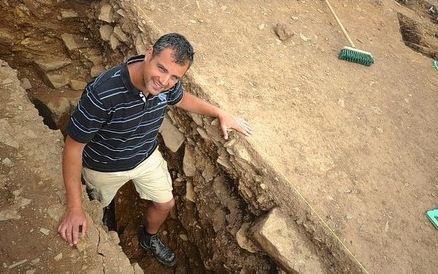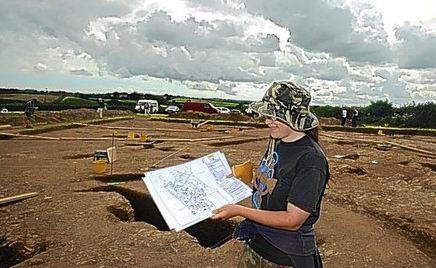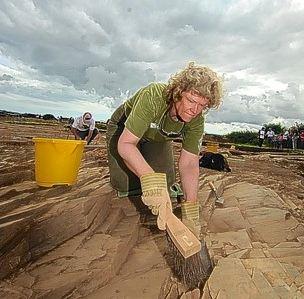Source - http://www.thisisexeter.co.uk/softly-softly-Roman-conquest/story-16796693-detail/story.html
Commanded by Vespasian, who was later to become a Roman emperor, the Second Augustan Legion arrived in what was to become Exeter around AD 50-55.
A fortress was established overlooking the River Exe that became the base for 5,000 soldiers and their families, with further settlements being established outside its gates.

Digging in: Site supervisor Marc Steinmetzer in what is believed to be a quarry pit Pictures: James Millar
This much we know, although these facts were established only relatively recently following excavations in the Seventies.
What remains unclear is quite what the indigenous population, members of the Dumnonii tribe, made of the sudden arrival of foreign invaders.
No evidence of great battles has been uncovered to date but, increasingly, there are signs of a peaceful co-existence and an assimilation of Roman culture.
And that is why the excavations at a newly discovered settlement are so important. Dr Ioana Oltean and Dr Martin Pitts, the University of Exeter's Roman archaeology specialists, together with Danielle Wootton, Devon finds liaison officer for the Portable Antiquities Scheme (PAS), Sam Moorhead, national finds adviser for Iron Age and Roman coins for the PAS at the British Museum, and Bill Horner, county archaeologist at Devon County Council, are leading the archaeological research that is indicating the influence of the Romans could have been greater than previously thought.

When we visited, the site near Ipplepen was a hive of activity, although work to cover it over is likely to have been completed this week as the project progresses to the analyses of what has been found.
Danielle said: "We have only exposed a small fraction of what we think might be here. This dig covers a corner of one field and we think the site covers at least 13 fields."
The excavation has uncovered the remains of a round house, which were a kind of house lived in by native Britons such as the Dumnonii during the Iron Age.
They were typically round structures with a thatched roof and the lower walls were made of stone, or wattle and daub, and were unlike the Roman houses, which were usually square. The presence of Roman pottery indicates that the round house was still used after the Romans arrived.
Danielle added: "Previously there was little evidence of any Roman influence beyond Exeter. We are starting to see more evidence of Roman influence further into Devon and Cornwall through new discoveries such as at Calstock and now this large Romano-British settlement.
"What is interesting on the site is that, despite the presence of Roman pottery and coins, the inhabitants are still living in native roundhouses, as Britons had done for centuries before, so they are maintaining some traditional ways while adapting to the influence of the Roman empire."
It is impossible to guess what the purpose of this building was, whether it be stabling for horses or habitation.

"We started to get excited about what might be here because of the volume of coins that were discovered by metal detectorists Dennis Hewings and Phillip 'Jim' Wills," said Danielle, "They had been scouring this area with the permission of the landowner and recording every scrap of metal."
Dr Martin added: "To put it in context, the volume of Roman coins previously discovered in Devon is in the mid-500s. There's probably been more than 100 discovered on this site alone. It's staggering."
The project, which took a year to plan, is providing the wider community, including Ipplepen residents, and University of Exeter students, with an opportunity for fieldwork experience and training with the support of three landowners.
And volunteers from international environmental charity Earthwatch, see panel, have travelled from Australia, Canada, the USA, and the Caribbean, specifically to work on the project, as well as involving Dennis and Jim.
More than 400 people visited the Ipplepen Community Hub where information about the dig was on display thanks to the university and the Portable Antiquities Scheme.
And the site is also continuing to throw up surprises.
Site director Marc Steinmetzer said: "The recovery of Middle Bronze Age pottery from a series of pits at the northern edge of the site has been really interesting. This would seem to indicate human activity on the site from around 1000BC. So, we are starting to gain a deeper understanding of the site in the mid to late Iron Age as well as continuation into the Romano-British period.
He also points us towards evidence of quarrying, possibly for iron ore. "There's no material from later periods that have been found in the quarry pit," said Marc, "So we may have evidence of the sort of industry that was being undertaken here 2,000 years ago."
The Dumnonii were farmers and fighters, living in round houses with walls made of clay, dung and twigs.
The men wore their hair long, had moustaches and wore animal skins, painting their bodies blue in battle.
Establishing exactly how they got on with their new foreign neighbours will help fill in some significant gaps in Devon's, and Britain's, history.
Sam Moorhead believes that this is one of the most significant Roman discoveries in the country for many decades. He said: "It is the beginning of a process that promises to transform our understanding of the Roman invasion and occupation of Devon."
Significant funding for this excavation came from the British Museum, as well as the University of Exeter, The Portable Antiquities Scheme, Earthwatch, the British Museum and Devon County Council, and the team are hopeful they will be able to continue exploring the site in coming years, as long as more money is forthcoming.
"We really have only scratched the surface – it is exciting to imagine what else we may find," said Danielle. "The geographical survey showed the area we exposed was the simplest in this particular field so we know there is a lot more to see.
"And what this shows is how important it is for archaeologists to work together with metal detectorists and we encourage them to continue to record all of their finds with us as it is helping us form a much clearer picture of Devon's history."
Anyone who wants to keep up to date with the work can visit http://blogs.exeter.ac.uk/ and look for Ipplepen Archaeological Project 2012.